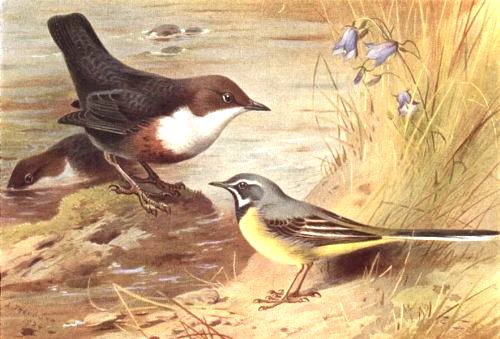grey wagtail
This is a striking bird that is found next to brooks and on floodplains, but can be found also near water purification plants. This yellow bird tears up and down with its long thin tail and is therefore easily recognizable.
and they have a sharp call that is often given in flight.
The species is always associated with running water when breeding, although they may use man-made structures near streams for the nest.
grey wagtail
Recognize large yellow mercury tail grey wagtail is easy: it has a whipping tail and a bright yellow belly. The male has a black throat.
During wintertime colur on the back is much lighter grey. The legs are light brown, the yellow mercury has black legs.
The species looks somewhat similar to the yellow wagtail but has the yellow on its underside restricted to the throat and vent.The legs are light brown, the yellow mercury has black legs.
The species is widely distributed, with several populations breeding in Europe and Asia and migrating to tropical regions in Asia and Africa.They winter in Africa and Asia.

In Europe the nests are often made in holes in manmade structures. The clutch consists of 3–6 speckled eggs and multiple broods may be raised with declining numbers in the clutch in subsequent broods.[10] The usual clutch size is five
 White troated dipper, Grey wagtail, and a flowering creeping bellflower on an illustration from Thorburn.
White troated dipper, Grey wagtail, and a flowering creeping bellflower on an illustration from Thorburn.
White-throated dipper and the Grey wagtail occupy the same habitat (fast moving brooks) , and feed on the aquatic insects and crustaceans. But the grey wagtail is more flexible and has a much larger distribution. The white-troated dipper hunts mostly by walking above the water, clenching to the rocks, sometimes diving. The Grey wagtail walks mostly near the border and feeds mostly on flying prey.
These birds feed on a variety of aquatic invertebrates including adult flies, mayflies, beetles, crustacea and molluscs.
References
1 Bekijk hier meer illustraties van Tassenbuch aus Vogelbesstimmen , Dr Kurt Floericke, Stuttgart, 1920.
2 the influence of stream acidification and riparian land use on the feeding ecology of Grey Wagtails Motacilla cinerea in Wales S. J. ORMEROD, STEPHANIE J. TYLER
4 Archibald Thorburn ( 1860 – 1935 ) Hascombe Surrey, een Schotse aquarelist. Hij werd bekend om de mooie afbeeldingen
van vooral vogels tegen een dramatische achtergrond.
Een bekend werk van hem is: Eggs from Familiar Wild Birds. bekijk: :kwartelkoning of spriet
koolmees
koperwiek
bosmuis
kleine plevier
strandplevier
krombekstrandloper
Grotegele kwikstaart
5 Alfred Edmund Brehm (1829 – 1884) was een Duitse bioloog welke enkele mooie boeken heeft geschreven over de dierenwereld. Bekend zijn: Het Leven der Dieren en Brehms Tierleben/ Bekijk:
slangen
wantsen
slakken
eekhoorn
egel
degenkrab
zilvermeeuw
zeekat
kabeljauw
vink en distelvink
salamanders
nachtvlinders
wolzwever, aardhommel
zijdevlinder
salamanders
infusoria
poliep of hydra
Portugees oorlogsschip
raderdiertjes of rotiferia
muurhagedis
mosselkreeftje
schorpioenvlieg
spiraalkokerworm
passiflora
6 Richard Lydekker ( 1849- 1915) was een
Engelse illustrator, bioloog en reisde graag en veel.
op deze website zijn te vinden:
zwarte rat
dwergmuis
muurhagedis
“zomer “
grote gele kwikstaart
bosmuis
veldmuis
rode poon
